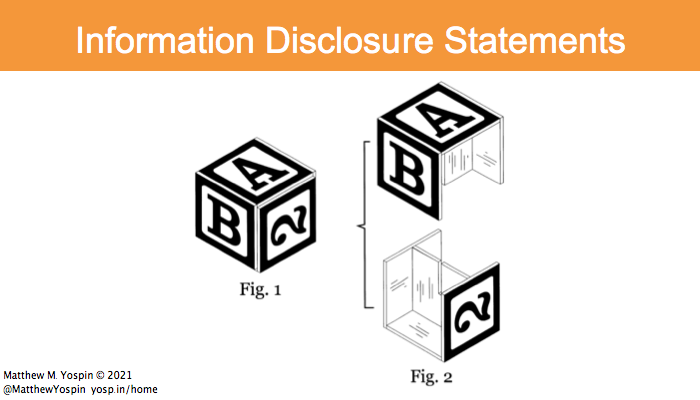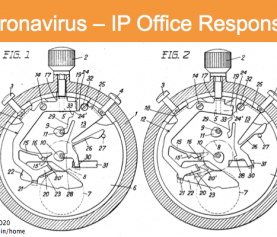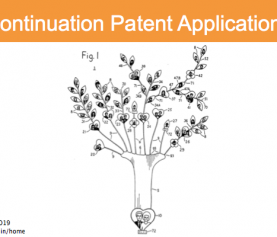Information Disclosure Statement in Patent Applications
What is an information disclosure statement in a patent application, and why is it crucial to your patent application? An information disclosure statement is a statement that you must make in a patent application, if there is information that’s material to the patentability your invention: the subject of your patent application. You may see information disclosure statement abbreviated as IDS.
What is material information?
Material information could be just about anything: it could include U.S. patents and U.S. patent applications. Information that is material to your patent application could be foreign patents and foreign patent applications.
Material information can also be anything else that bears on whether your invention is patentable. This list could be things like journal articles, white papers, crowdfunding campaigns, social media posts, or other products or services that are on the market that you know of. And just about anything else.
When do you have to file an information disclosure statement?
You don’t have to file an information disclosure statement exactly when you file a patent application. You can file it up to three months after. There’s a good reason for that: sometimes you need to file an application in a hurry. After you do, you get the three months to gather the info that goes into the information disclosure statement and file it.
If your patent application is already pending, there are still opportunities to file an IDS. This depends on where your application is in the filing stage in examination: have you gotten a first office action or not? Have you gotten a final office action? Have you already paid an issuance fee?
The ability to file an information disclosure statement, and any fee that you have to pay as a penalty for late filing of the IDS, depends on two things. First, the stage of the patent application. Second, on when you learned of the prior art that you need to disclose. If you learned of the relevant prior art recently – within three months – there may not be a fee. If it was more than three months ago, there probably is a fee.
How do you file an information disclosure statement?
It’s important that when you’re preparing the application, you give good invention disclosure and information disclosure. This means disclosure to your patent attorney of all known and relevant prior art. As a client, you should tell your patent attorney about what you know of and how to find it. If it’s patents or patent applications, that’s relatively simple: you list those on the form. If the prior art is something else – a white paper, a journal article, a product or service that exists – you have to provide information on where the USPTO can find it. You’ll also have to provide a copy of the material.
When you are preparing the application, it’s important to provide this info. If you file the patent application as an emergency filing, or must rush to beat a deadline, then you can provide the IDS later, after you’ve gotten the patent application filed. Keep in mind: if it’s something that you learned about after your application is pending, tell your attorney about it as soon as possible. That way, you can prepare and file an information disclosure statement, hopefully before a three-month deadline, and therefore avoid having to pay an extra fee to the USPTO for it.
The requirement that you disclose applies to anything that the client, the inventor, the invention owner, or the attorney or law firm knows about. The law and requirements for an IDS are in MPEP 609, and 37 C.F.R. 1.97.
More advantages to filing an IDS
There are other advantages to you in filing an IDS. It can strengthen the patent application, because you won’t spend time talking in the patent application about information that you already know about that’s already patented or that’s already described somewhere. Because you’re not going to get that patented, you can focus on your improvements.
Filing an IDS can lower the cost of the patent application because you don’t have to spend time describing things that are already known. You can phrase your application as: here’s something we know about, here is a problem with it, and here’s why our invention solves it and is better, and therefore deserves to be patented.
Lastly, this can also help prevent your patent from future attack once it’s issued or during the examination process – because if someone tries to invalidate your patent by saying: there’s already known prior art that’s out there, and so this shouldn’t have been issued, you can say: no, we disclosed that, the USPTO Examining Attorney knew about it, and we had it considered during examination, and our invention was still found to be patentable, even in light of this prior art that was known.
I chose the images for this post from US Design Patent 482538, for “Toy block incorporating a seat and table for children”. Why? Because patents and inventions build on prior knowledge, and can be put together in new and inventive (and non-obvious!) ways.
If you’ve got questions about an information disclosure statement or about the importance of them, what goes into them, or how to prepare them, let me know. Call me at 617-340-9295 or email me at my Contact Me page. Or, find me on LinkedIn, YouTube, Facebook, Twitter, or Avvo.






